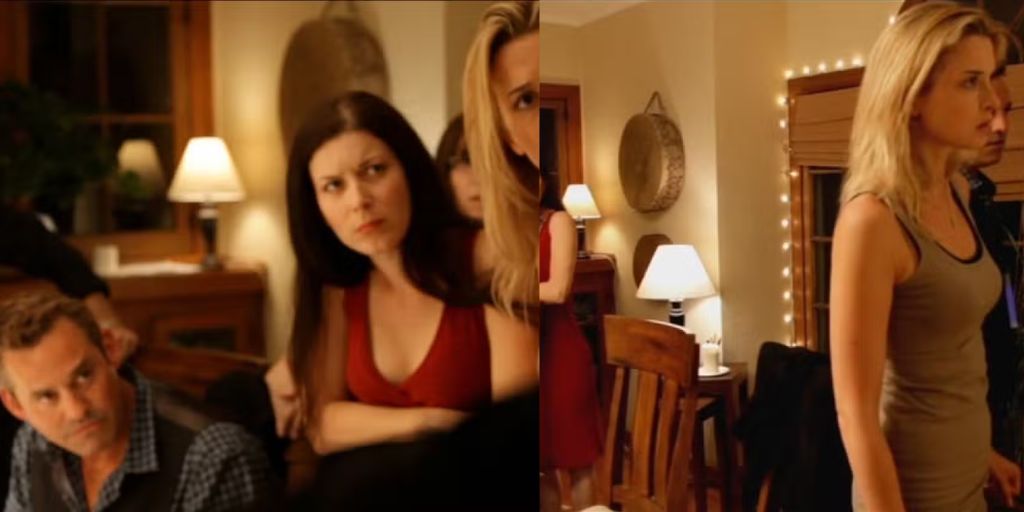Low-budget filmmaking is often seen as a challenge in the cinema world. Many believe that to create a great film, you need a large budget, high-end technology, and a team of experts. However, there are exceptions to this belief. One such exception is the film Coherence, released in 2013.
This movie is a shining example of how a small budget can still yield big ideas and meaningful storytelling. It proves that filmmakers can create engaging content without the need for major studio backing or expensive special effects.
The film’s director, James Ward Byrkit, adopted a resourceful approach similar to that of Robert Rodriguez, a filmmaker known for his ability to make movies on limited budgets. Rodriguez famously made El Mariachi with only $7,000, and Byrkit followed a similar path. He had a strong cast, a house to film in, and an interesting concept. With these elements, he crafted a film that resonates with audiences on many levels.
The Story of Coherence
Coherence tells the story of a dinner party that goes horribly wrong. Eight friends gather for a seemingly normal evening, but as the night unfolds, strange and unsettling events occur. The film fits into the category of cosmic horror, a genre that emphasizes the fear of the unknown. In Coherence, the unknown is represented by the bizarre changes in reality that the characters experience.
The film begins with the characters interacting in their usual manner. Among them are Em and Mike, played by Emily Baldoni and Nicholas Brendon, respectively. Em is hesitant about her relationship with Mike, and their discussions highlight their complicated feelings. Other characters include Laurie, Lee, Amir, and Beth, each with their own backstories and relationships that add depth to the narrative.
As the story progresses, the characters face an unexpected challenge when the power goes out. This event triggers a series of strange occurrences, leading them to question their understanding of reality. The arrival of doppelgangers and the influence of Miller’s Comet add further confusion and tension.
The film skillfully combines elements of science fiction with the personal struggles of the characters, resulting in a rich narrative filled with suspense and intrigue.
Character Dynamics and Relationships
The characters in Coherence are not just random friends thrown together; they each have their own histories and relationships that shape the story. The dynamics among them are complex. Emily and Kevin are a couple, but their relationship is shaky.
Emily is hesitant to join Kevin on a work trip abroad, which creates tension between them. Adding to this complication is Laurie, Kevin’s ex-girlfriend, who tries to rekindle her relationship with him during the party. This love triangle introduces emotional depth and drama to the plot.
The film’s dialogue feels natural and improvised. The characters speak to each other as real friends would, which makes their interactions believable. As the story progresses, their discussions become increasingly frantic as they attempt to understand what is happening around them. The atmosphere becomes tense as the reality they knew begins to unravel.
This scheme of personal relationships is a key element of the film. The characters’ feelings, desires, and fears emerge in the midst of the chaos. As they confront the unknown, they are forced to deal with their own insecurities and relationships. The film expertly balances the cosmic horror elements with these personal struggles, creating a compelling narrative that keeps the audience engaged.
Improv and Minimalism in Filmmaking
One of the standout features of Coherence is its use of improvisation. Byrkit took a unique approach by casting actors known for their improv skills. He provided them with basic character motivations and a loose outline of the plot but allowed them to create their dialogue and interactions. This technique adds a sense of authenticity to the film and contributes to the feeling of spontaneity throughout the story.
Byrkit’s decision to embrace minimalism is also evident in the film’s production. With a small budget, he relied on a straightforward approach to filmmaking.
The film is shot in a single location, which adds to the claustrophobic feel. The lighting is simple, yet effective, reinforcing the sense of being trapped in a strange reality. The characters are confined to the house, creating an atmosphere of tension and uncertainty.
This minimalist style is reminiscent of the classic anthology series The Twilight Zone, which inspired Byrkit. The show often shows strange and unsettling themes, leaving audiences with more questions than answers. Similarly, Coherence raises philosophical questions about reality, identity, and the nature of existence.
The film’s narrative and visual style work together to create an experience that feels both fresh and reminiscent of classic sci-fi storytelling.
Philosophical Themes and Ideas
At its core, Coherence is not just a sci-fi thriller; it is a film that challenges the audience to think deeply about complex ideas. The themes presented in the film touch on personal identity, the nature of reality, and the implications of free will. These concepts are shown through the characters’ experiences as they face a world where the rules of reality seem to have changed.
One of the key philosophical ideas in the film is the concept of Schrödinger’s Cat, a thought experiment in quantum mechanics. This idea illustrates the uncertainty of reality, where a cat in a box can be simultaneously alive and dead until observed. In Coherence, the characters find themselves in a similar situation.
They are faced with multiple versions of themselves, leading to questions about identity and existence. The film challenges viewers to consider what makes us who we are and how our choices shape our reality.
The passing of Miller’s Comet serves as a catalyst for the characters’ existential crisis. Its influence disrupts their understanding of reality, forcing them to confront their fears and uncertainties. The comet symbolizes the unknown, a force that alters the fabric of their lives. As the characters grapple with the changes around them, they must also confront their own desires and motivations.
This scheme of big ideas is what sets Coherence apart from other sci-fi films. While it may not have the visual effects or elaborate sets of larger productions, it compensates with its thought-provoking themes and strong character development. The film challenges audiences to engage with its narrative on a deeper level, making it a memorable entry in the science fiction genre.
The Reception of Coherence
Despite its innovative approach and thought-provoking themes, Coherence has remained somewhat underappreciated. It did not receive the same level of attention as other indie films or major sci-fi releases. However, those who have seen it often praise its originality and depth. The film’s unique style and narrative structure have garnered a cult following among fans of independent cinema and science fiction.
Critics have noted that Coherence is a bold experiment in no-budget filmmaking. Its mix of sci-fi concepts with strong character dynamics creates a film that feels both unique and messy at times. While it may not be perfect, its ambition is commendable. The film’s short runtime of just under 90 minutes makes efficient use of its time, packing in numerous complex ideas and character moments.
Acting in Coherence is another aspect that has received positive feedback. The performances of the cast upgrade the material, bringing authenticity to their characters. The actors’ ability to improvise adds a layer of realism to the film, making the audience feel as if they are witnessing genuine interactions among friends. This commitment to character development is one reason why Coherence stands out among other low-budget films.
A Testament to Indie Filmmaking
Coherence serves as a testament to what indie filmmaking can achieve. It demonstrates that with creativity, resourcefulness, and a talented cast, filmmakers can create compelling narratives that resonate with audiences. The film shows that big ideas do not require big budgets; rather, they can emerge from simple yet profound storytelling.
Byrkit’s success with Coherence is significant not only for its contribution to the genre but also for its impact on independent filmmaking as a whole. It showcases the potential of small productions to tackle complex themes and engage viewers in meaningful ways. In an era when big-budget blockbusters often dominate the box office, Coherence reminds us that smaller films can deliver powerful messages and thought-provoking narratives.
The film’s legacy continues to inspire aspiring filmmakers and artists. It serves as a reminder that creativity can flourish in the face of limitations. Coherence encourages filmmakers to take risks, experiment with their craft, and embrace unconventional storytelling methods. Its influence can be seen in the growing number of indie films that tackle complex themes and push the boundaries of traditional narrative structures.
Conclusion: A Lasting Impact
Coherence stands out as a remarkable achievement in low-budget filmmaking. Its ability to blend high-concept science fiction with a genuine character scheme makes it a unique entry in the genre. The film’s minimalist approach, combined with its improvisational style, creates a sense of authenticity that resonates with viewers.

The philosophical themes shown in Coherence challenge audiences to reflect on their own understanding of reality, identity, and the nature of existence. Despite its underappreciation, the film has garnered a loyal following and continues to inspire filmmakers and fans alike.
Coherence is a reminder that storytelling knows no bounds and that even the simplest of setups can lead to a profound scheme. It encourages viewers to embrace the unknown and to appreciate the beauty of creativity, no matter the budget.
Through its innovative approach and thought-provoking ideas, Coherence has secured its place in the pantheon of indie films that have successfully captured the imagination of audiences worldwide.





